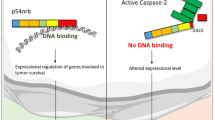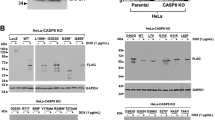Abstract
Caspase-7 is a caspase involved in the execution phase of apoptosis. To explore the possibility that the genetic alterations of CASPASE-7 might be involved in the development of human cancers, we analysed the entire coding region and all splice sites of human CASPASE-7 gene for the detection of somatic mutations in a series of human solid cancers, including carcinomas from stomach, colon, head/neck, esophagus, urinary bladder and lung. Overall, we detected CASPASE-7 mutations in two of 98 colon carcinomas (2.0%), one of 50 esophageal carcinomas (2.0%) and one of 33 head/neck carcinomas (3.0%). We expressed the tumor-derived caspase-7 mutants in 293 T cells and found that the apoptosis was reduced compared to the wild-type caspase-7. This is the first report on the CASPASE-7 gene mutations in human malignancies, and our data suggest that the inactivating mutations of the CASPASE-7 gene might lead to the loss of its apoptotic function and contribute to the pathogenesis of some human solid cancers.
This is a preview of subscription content, access via your institution
Access options
Subscribe to this journal
Receive 50 print issues and online access
$259.00 per year
only $5.18 per issue
Buy this article
- Purchase on Springer Link
- Instant access to full article PDF
Prices may be subject to local taxes which are calculated during checkout



Similar content being viewed by others
Abbreviations
- PCR:
-
polymerase chain reaction
- DAPI:
-
4′, 6-diamidine-2′-phenylindole dihydrochloride
- GFP:
-
green fluorescent protein
- SSCP:
-
single strand conformation polymorphism
- LOH:
-
loss of heterozygosity
- TRAIL:
-
tumor necrosis factor-related apoptosis-inducing ligand
References
Boldin MP, Goncharov TM, Goltsev YV and Wallach D . (1996). Cell, 2, 803–815.
Chai J, Shiozaki E, Srinivasula SM, Wu Q, Datta P, Alnemri ES, Shi Y and Dataa P . (2001). Cell, 104, 769–780.
Duan H, Chinnaiyan AM, Hudson PL, Wing JP, He WW and Dixit VM . (1996). J. Biol. Chem., 271, 1621–1625.
Fulda S, Kufer MU, Meyer E, van Valen F, Dockhorn-Dworniczak B and Debatin KM . (2001). Oncogene, 20, 5865–5877.
Hanahan D and Weinberg RA . (2000). Cell, 100, 57–70.
Hirata H, Takahashi A, Kobayashi S, Yonehara S, Sawai H, Okazaki T, Yamamoto K and Sasada MJ . (1998). J. Exp. Med., 187, 587–600.
Krawczak M, Reiss J and Cooper DN . (1992). Hum. Genet., 90, 41–54.
Kurokawa H, Nishio K, Fukumoto H, Tomonari A, Suzuki T and Saijo N . (1999). Oncol. Rep., 6, 33–37.
Lee JY, Dong SM, Kim SY, Yoo NJ, Lee SH and Park WS . (1998). Virchows. Arch., 433, 305–309.
Lee SH, Shin MS, Park WS, Kim SY, Kim HS, Han JY, Park GS, Dong SM, Pi JH, Kim CS, Kim SH, Lee JY and Yoo NJ . (1999). Oncogene, 18, 3754–3760.
Lippke JA, Gu Y, Sarnecki C, Caron PR and Su MS . (1996). J. Biol. Chem., 271,1825–1828.
Mandruzzato S, Brasseur F, Andry G, Boon T and van der Bruggen PA . (1997). J. Exp. Med., 186, 785–793.
Mitelman F, Mertens F and Johansson B . (1997). Nat. Genet., 15, 417–474.
Mollenhauer J, Herbertz S, Helmke B, Kollender G, Krebs I, Madsen J, Holmskov U, Sorger K, Schmitt L, Wiemann S, Otto HF, Grone HJ and Poustka A . (2001). Cancer Res., 61, 8880–8886.
Nicholson DW . (1999). Cell Death Differ., 6, 1028–1042.
Pai JT, Brown MS and Goldstein JL . (1996). Proc. Natl. Acad. Sci. USA, 93, 5437–5442.
Palmerini F, Devilard E, Jarry A, Birg F and Xerri L . (2001). Hum. Pathol., 32, 461–467.
Reed JC . (2000). Am. J. Pathol., 39, 1415–1430.
Schwartz Jr S, Yamamoto H, Navarro M, Maestro M, Reventos J and Perucho M . (1999). Cancer Res., 59, 2995–3002.
Shin MS, Kim HS, Kang CS, Park WS, Kim SY, Lee SN, Lee JH, Park JY, Jang JJ, Kim CW, Kim SH, Lee JY, Yoo NJ and Lee SH . (2002). Blood, 99, 4094–4099.
Shin MS, Park WS, Kim SY, Kanf SJ, Song KY, Park JY, Dong SM, Pi JH, Oh RR, Lee JY, Yoo NJ and Lee SH . (1999). Am. J. Pathol., 154, 1785–1791.
Slee EA, Adrain C and Martin SJ . (2001). J. Biol. Chem., 276, 7320–7326.
Slee EA, Harte MT, Kluck RM, Wolf BB, Casiano CA, Newmeyer DD, Wang HG, Reed JC, Nicholson DW, Alnemri ES, Green DR and Martin SJ . (1999). J. Cell Biol., 144, 281–292.
Teitz T, Wei T, Valentine MB, Vanin EF, Grenet J, Valentine VA, Behm FG, Look AT, Lahti JM and Kidd VJ . (2000). Nat. Med., 6, 529–535.
Tewari M, Quan LT, O'Rourke K, Desnoyers S, Zeng Z, Beidler DR, Poirier GG, Salvesen GS and Dixit VM . (1995). Cell, 81, 801–819.
Zörnig M, Grzeschiczek A, Kowalski MB, Hartmann KU and Möröy T . (1995). Oncogene, 10, 2397–2401.
Acknowledgements
This study was supported by funding from the 21C Frontier Functional Human Genome Project from the Ministry of Science and Technology of Korea (M101KB010001-02K0201-03710).
Author information
Authors and Affiliations
Corresponding author
Rights and permissions
About this article
Cite this article
Soung, Y., Lee, J., Kim, H. et al. Inactivating mutations of CASPASE-7 gene in human cancers. Oncogene 22, 8048–8052 (2003). https://doi.org/10.1038/sj.onc.1206727
Received:
Revised:
Accepted:
Published:
Issue Date:
DOI: https://doi.org/10.1038/sj.onc.1206727
Keywords
This article is cited by
-
A Review on Caspases: Key Regulators of Biological Activities and Apoptosis
Molecular Neurobiology (2023)
-
Long non-coding RNA TPT1-AS1 sensitizes breast cancer cell to paclitaxel and inhibits cell proliferation by miR-3156-5p/caspase 2 axis
Human Cell (2021)
-
Genetic characterization of two gain-of-function alleles of the effector caspase DrICE in Drosophila
Cell Death & Differentiation (2016)
-
CASP7 variants modify susceptibility to cervical cancer in Chinesewomen
Scientific Reports (2015)
-
Old, new and emerging functions of caspases
Cell Death & Differentiation (2015)



